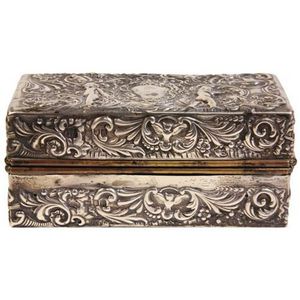Regency-style French Writing Box with Brass and Tortoise Shell Veneer
You must be a subscriber, and be logged in to view price and dealer details.
Subscribe Now to view actual auction price for this item
When you subscribe, you have the option of setting the currency in which to display prices to $Au, $US, $NZ or Stg.
- Acanthus - A stylized leaf motif, one of the primary decorative elements of classical Greek and Roman architecture, derived from the genus of flowering plants in the family Acanthaceae, native to tropical and subtropical regions of the Mediterranean area. It is a common element in classical Greek and Roman design, and is often seen in Corinthian and Composite order columns and used as a decorative element in English, European and Australian furniture, particularly on the curve of a leg, and as decoration for a corbel.
- Regency Period - The Regency period in English furniture design refers to the period when King George III, was declared unfit to rule in 1811, and his son ruled as proxy as Prince Regent, until 1820, and then, after the death of his father as George IV until his death in 1830. The Regency period was preceded by the Georgian period (George I, George II, and George III: 1714 - 1811), and was followed by the William IV period, which only lasted until 1837 when William IV died as was succeeded by Queen Victoria.
- Incised - A record of a name, date or inscription, or a decoration scratched into a surface, usually of a glass or ceramic item with a blunt instrument to make a coarse indentation. Compare with engraving where the surface is cut with a sharp instrument such as a metal needle or rotating tool to achieve a fine indentation.
- Tortoiseshell - Tortoiseshell is a translucent material that comes from the horny carapace of a certain types of turtles, including the hawksbill turtle. It is often therefore mounted on a colour underground - often red - or inlaid with gold or silver thread, as seen in Boulle furniture.
The texture and colour nuances of the material are extremely important. Heated tortoiseshell can easily be formed into various shapes. Like other natural materials, tortoiseshell becomes more beautiful with use. In a time before plastic, tortoiseshell was widely used for small objects such as combs and powder compacts.
In 1973, the trade of tortoiseshell worldwide was banned under CITES (The Convention on International Trade in Endangered Species). Prior to importing or exporting items containing tortoiseshell a CITES permit must be obtained. Tortoiseshell items cannot be traded on Ebay.
"Faux tortoiseshell", another case of man initiating nature, is made from old-style plastics such as celluloid and cellulos and is coloured with red, yellow and brown spots to imitate the genuine article. It is commonly used in glasses frames, musical instruments and costume jewellery. - Boulle - Boulle work is the name given to tortoiseshell and metal inlay using brass and sometimes silver, found on furniture and smaller wooden objects. It originated in Italy but was developed by Frenchman Andre Charles Boulle (1642 - 1732) under Louis XIV.
Boulle was appointed Royal Cainet Maker to Louis XIV and designed furniture and clockcases for the monarch.
In preparation, the tortoiseshell and metal were cut together following a design, using a fine fret saw.
In the application of the Boulle, the carcase of piece of furniture was covered with the tortoiseshell which in turn was inlaid with the matched designs in metal, which in turn was elaborately engraved.
The use of Boulle work furniture continued mainly in France until the 19th century.
This item has been included into following indexes:
Visually similar items

Baluch Sumak rug modern 153 x 101 cm

English hallmarked sterling silver Victorian travelling ink well decorated with raised putti and birds, with a silver plated insert marked 'Electroplate Paris' London, 1896, maker Goldsmiths & Silversmiths Co dimensions 10.5 x 5.5 x 4 cm

New Zealand native timbers marquetry box, oblong shape the hinged lid inlaid with native birds and chicks in a landscape

A Tibetan thangka ink and colour on paper, 80 x 55 cm
